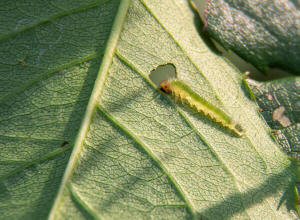|
 University
of Illinois Extension University
of Illinois Extension
Why are there holes in my roses?
Roseslugs
 Send a link to a friend
Send a link to a friend
[June 27, 2024]
Roses are grown in many gardens for their
large, showy, often fragrant flowers. If you grow roses, you may
have noticed something eating the leaves of your plants, causing
them to become unsightly. |
|
 While
Japanese beetles often get much of the blame during the summer
months, they aren’t the only insects that will feed on the foliage
of roses. Roseslugs can also frequently be found feeding on and
damaging rose leaves. While
Japanese beetles often get much of the blame during the summer
months, they aren’t the only insects that will feed on the foliage
of roses. Roseslugs can also frequently be found feeding on and
damaging rose leaves.
What are roseslugs?
Roseslugs are caterpillar-like insects. Three different species of
roseslugs can be found in Illinois: the European roseslug (Endelomyia
aethiops), the curled rose sawfly (Allantus cinctus), and the
bristly roseslug (Cladius difformis).
Despite their common name and appearance, they are neither slugs nor
caterpillars but rather sawflies. Sawflies are related to bees,
ants, and wasps (Hymenoptera) and are often considered pests because
they feed on plants. Sawflies get their common name from their
saw-like ovipositor (egg-laying structure) that they will use to cut
slits into the stems or leaves of plants to lay their eggs.

Life cycle and damage
European roseslug larvae are light green with orange heads and will
grow to be about ½ inch long. They feed on the upper surfaces of
leaves, leaving behind the veins and lower leaf surface from May
through June. When they are done feeding, they will leave the plant
and pupate in the ground, where they will remain until the following
spring (one generation per year). The adults will emerge in spring,
and eggs will be laid in pockets near the edges of leaves. [to top of second
column] |

Curled rose sawflies are green with white spots and
have yellow heads with a dark stripe down the middle. They will grow
to be around ¾ inch long. When small, they will skeletonize leaves
and, as they grow larger, will eventually eat the entire leaf except
for the main leaf vein. In addition to their feeding damage, when
they pupate, they will bore into twigs, particularly those that have
been pruned, which can further damage plants. They will often curl
up when resting, thus their common name. There are two generations
per year.
Bristly roseslugs are green, with fine, hairlike
spines, and grow to about ½ inch long. When small, they will feed on
the undersides, causing them to have windowpane-like damage (the
upper leaf surface is all that is left). As the larvae get larger,
they eat the entire leaf except for large veins. When they are done
feeding, they spin a cocoon in plant debris or on the plant
themselves. There can be six or more generations per year, meaning
they are capable of causing extensive damage, especially towards the
end of the growing season. Eggs are laid in the midribs of leaves.
[SOURCE/WRITER: Ken Johnson,
Horticulture Educator, Illinois Extension]

|